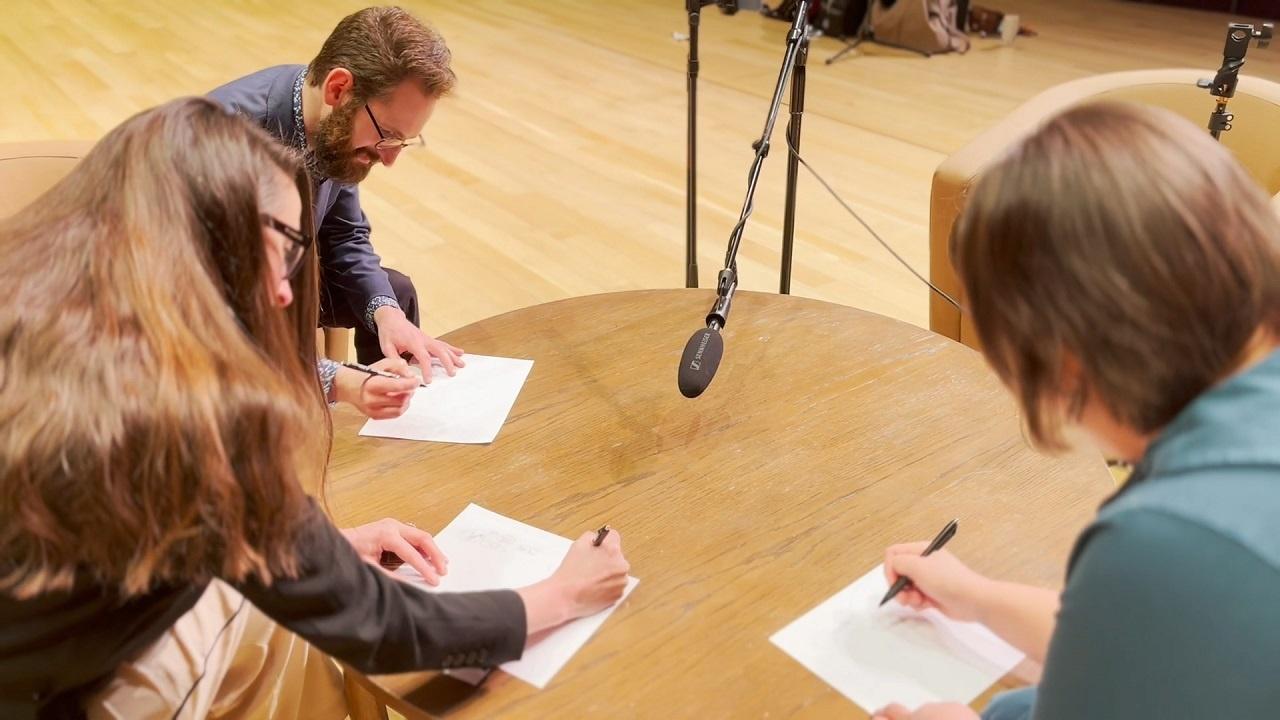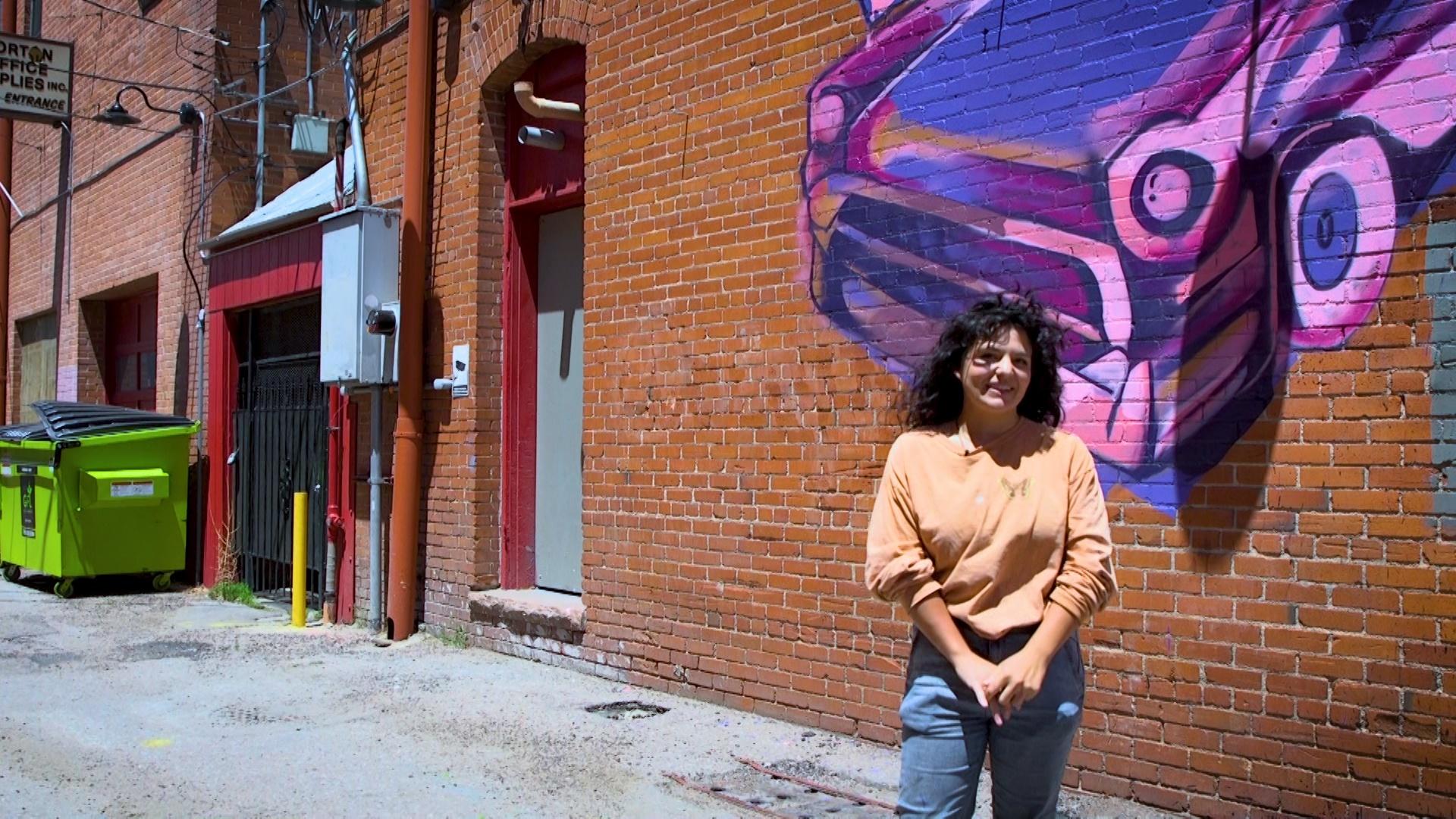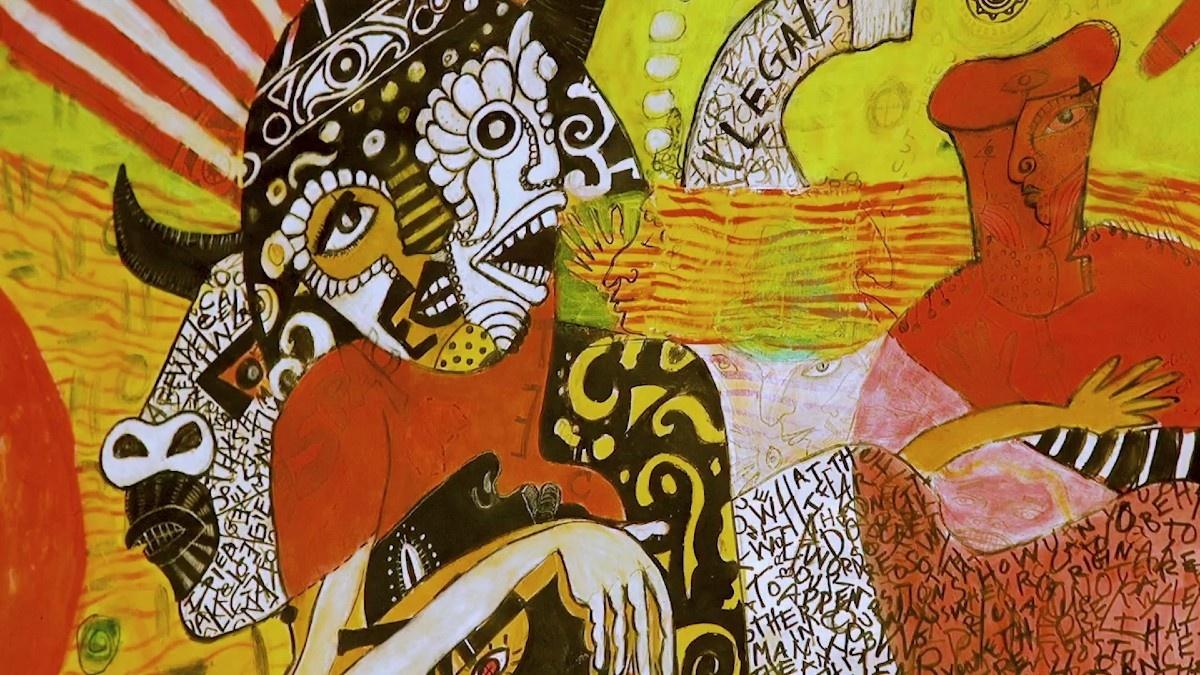Claire Swinford (CS): I tried to map out the trajectory for myself: being in journalism, in the nonprofit fundraising sphere, and then jumping into nonprofits whole hog with the Philharmonic, where I think [Siegel] and I missed overlapping by not very long. I demonstrate Downtown Ventures as, I guess it's a right hand turn on the map. But for me, it's a left hand turn into the realm of community development and public art. With sort of a more natural line back to the Bee Vradenburg Foundation.
I like the idea of mapping it out because there is this sort of landscape in which we're crossing paths over and over, and under, and sideways. And I think that to be able to chart how David sort of goes this way — and Michelle is making some sort of like weird curly q back up — that’s an accurate portrait of how it works to have a career in the arts in sort of a ‘second-city’ environment.
David Siegel (DS): We all started here, we all left, and we’ve all returned. And we've been in this strange spinning pattern of continuation. I left the Bee Vradenburg Foundation and came to the Ent Center. Michelle left the Ent Center and made some stops along the way before coming to Downtown Partnership. And Claire left Downtown Partnership, and is now the Executive Director of the Bee Vradenburg Foundation.
Michelle Winchell (MW): I was at Indiana University in an MFA program, and then went to Denver where I worked at a branding agency. Then back to Colorado Springs to be part of the team that opened the Ent Center, to the Fine Arts Center, and then to Downtown Partnership. And you can see that we have all of these entangled pathways and crossings.
DS: I think there are strengths and weaknesses in this structure. Colorado Springs is somewhat notoriously less welcoming than we should be to outsiders. I think it's really hard to come into Colorado Springs and be welcomed as arts leaders sometimes. And because of that, I think we miss out on really good ideas from outside of the community. On the flip side, we can sit down and have this conversation, and there is instant rapport. And we know what the others are dealing with and we are happy to share ideas and experiences. So, pros and cons.
MW: One of the things I love about the Colorado Springs art community is the enthusiasm around new ideas or ventures that I haven't necessarily experienced other places I've lived. If you are in more of a major market, and it can be, Oh, that person's competing with me, or, There's not enough space for everyone. And mostly my experience here has been enthusiasm, embracing the new idea.
I lived other places for 10 years and then came back, but got to say, ‘Oh, I grew up here.’ And so there was some sort of instant, ‘Oh, okay. So you know our community.’ Even though, after 10 years, I really didn't know major players in town when I first came back.
CS: There's that duality of like, ‘This is mine. I worked so hard for this.’ And also, ‘Wow, we're finally getting noticed? And somebody wants to come here from where and be part of this?’ So there's this dual pride and parochiality at the same time. The past 10 years have seen those two things in tension with one another. And as children of this community, we've seen both the best and the worst of that. Building a career in the arts in a town that has operated in a scarcity mentality where the arts are concerned… it does feel like you're kind of in the same sandbox with the same half dozen kids and the same four toys. And there’s never enough toys to go around.
MW: And we all wish there were more toys — and a bigger sandbox for everybody.
CS: And if the sandbox were bigger and if there were more toys, then the fact there are other kids who wanna come play would be no problem. Right? And I think we're starting to realize that the sandbox is getting bigger. But, there's a sort of mental shift that comes along with that. And some really wonderful things happen when that type of sharing becomes the norm.
As a studio artist who has had colleagues and friends go on to present shows in other cities, they are shocked. Like, ‘Oh, wow, there is a territoriality to the arts scene in this other place. There is a sense that, you know, if you go to this gallery, then you don't go to that gallery. If you're shown in this gallery, then you don't show in this place.
MW: I do think Colorado Springs artists celebrate each other's successes. It’s something that I've always appreciated.
DS: Colorado Springs has tended to play it safe. And I think that's changing. And that's really exciting. And as that risk aversion changes, our entire arts community will be more relevant and more vibrant. I think it's, in some ways, a generational shift that we are all part of.
CS: Do you feel like that's something we've seen before? The move from less risk to more risk, or more risk to less risk, like appetite for risk?
DS: What Fannie Mae Duncan was doing at the Cotton Club was full of risk. I think in the 90s, it swung back back in the other direction.
CS: Not to go full history museum on us, but risk was involved in creating a community that was intended to be a place for arts and learning in a part of the country that was known for mining and industry. There was a time where people aspired to come to Colorado Springs to learn their craft, and to become arts professionals.
DS: The Fine Arts Center, when it opened, was groundbreaking nationally.
MW: It won awards awards for architecture, and was one of the first facilities, I believe in the nation, that had a theater and an art museum — and had this kind of multidisciplinary approach all in one complex. So lots of new ground — for the time, especially.
CS: And they did this at a time where the nation was suffering economically like it had never done before. I remember reading something that said that at the height of the Great Depression, the first year that the Fine Arts Center had its doors open, fully half the city’s population came to an event in that building. Seeing the response on people's faces when you told them that there was this history here? It was a response that was energized, that was inspired. That was more proud of this place.
MW: Instead of it feeling like, Oh, I'm building something from scratch, it's the realization of, Oh, I’m the next generation of stewards of this vision to carry it forward and evolve it.
DS: So that in mind, how do you all want to steward this vision in our new roles?
CS: One of the first things I thought about taking on the role of Executive Director of the Bee Vradenburg Foundation was, the door has been open for me. How can I open it even wider for whoever's next? Starting to think critically about how equity gets built within the arts, how, systemic inequities get dismantled within the arts. And coming in to this position, just thinking about who’s gonna be next, and what are they going to need? And how is that different from what has gone before?
MW: I'm also very interested in, what are those equity pathways? How do we get people the resources they need to get their first public art commission? What are the tools that we develop for our own community so that people have those opportunities?
DS: There is a lot of value in new perspectives. And taking a pause, bringing new eyes in thinking about things differently, saying things differently.
MW: I'm so thankful that I can put together a list of questions and call Claire. That is a great gift and an amazing resource. But when I think about nonprofit arts structures overall, it's not great that there's one person carrying all that institutional knowledge. Like what if I didn't have that relationship? And I was trying to figure out all of the details and relationships and network and programming? That would be really difficult… Claire's a very thorough note-leaver.
DS: That makes me feel really bad. [Laughter.]
CS: It's such a specialized knowledge set. Sometimes you do have to know that if the fish sculpture falls down again, that you're gonna need this particular type of cable clamp in this size that can be found at this one hardware store in the entire city, and that, you know, in order to meet OSHA standards, you're gonna have to attach three of them at every cable break point. Like that's the kind of nonsense that…
MW: It’s very specific.
CS: Preparing someone to go into a career in the arts, that’s not the kind of stuff you think you're gonna have to learn. You know, certainly Downtown Ventures became the kind of the organism that it is because the premise is fundamentally exciting. And there were a large number of people who were willing to be very generous with their time and resources, because it just seemed like such fun. You invite people in and they go, ‘Wait, there's a role for me in this? I can use my competencies to make something cool? Like, this exists?’
Like the City Forestry department, we got a chance to install a piece from an artist from Brazil who needed a dead log. Forestry spent way too much time picking out the perfect dead log! They were jazzed.
We're all seeking that same reaction. We're all seeking that moment of like, ‘Whoa!’ And we don't get that in a vacuum. And that for me goes back to the question of like, what are we wanting to see happen? What is our hope for this? And it is that, at least for me, that all of those disparate populations and callings and areas of expertise, all of those wide range of individuals feel like, ‘This is mine.’
DS: Yeah. The arts changed my life. The arts are the reason I graduated from high school. And every student in the Pikes Peak region should have the same opportunities that I had. The arts continue to change my life — and every adult in the Pikes Peak region should have the same opportunities the arts that I have.
CS: Then we get into these granular conversations where we talk about how the arts are impacting outcomes for students. Or we're talking about how the arts are changing people's perception of what it means to be good stewards of our trails and open spaces. Or we're talking about how the arts are impacted by effective and accessible transit.
And all of a sudden we're talking about nearly everything that comes together to form a functioning and sustainable community for Colorado Springs. And if the arts can be one of the wheels on which those conversations turn, then I think the arts are doing a good thing for this region.
What I would hope that is that folks watching this just know that it's here. And that Colorado Springs people, Manitou Springs people, are gonna be absolutely overjoyed if you say, ‘Hey, I'm here from outta town. What do you got?’







